Abstract
To define the events necessary for the establishment and maintenance of repression in a λ-infected cell, we have studied the requirements for efficient synthesis of the cI protein (“λ-repressor”). Three classes of λ mutants defective in the establishment of repression are also defective in the appearance of cI protein activity at the normal time. Two of these mutational classes (cII- and cIII-) probably result from inactivation of λ-specified proteins, but the third class (cy-) may involve a structural defect. We conclude that at least three regulatory elements are likely to be required for the normal turn-on of cI protein synthesis in an infected nonlysogenic cell: cII and cIII proteins and an “active” y-region of λ DNA. From these and other results, the complete role of cII and cIII proteins in the establishment of repression may involve a bifunctional regulatory activity: positive regulation of the cI gene and negative regulation of late genes. A possible molecular model for cII and cIII action is discussed. Since the cII and cIII genes are repressed by the cI protein under conditions of stable lysogeny, a separate mechanism is required for the maintenance of cI protein synthesis. After infection of a lysogen by cII- phage, the rate of increase of cI protein activity is substantially greater than after infection of a nonlysogen. From these and other results, the cI protein may also have a bifunctional regulatory activity: positive regulation of the cI gene and negative regulation of early lytic genes.
Keywords: E. coli, lysogeny versus lysis, cy- mutants, DNA binding
Full text
PDF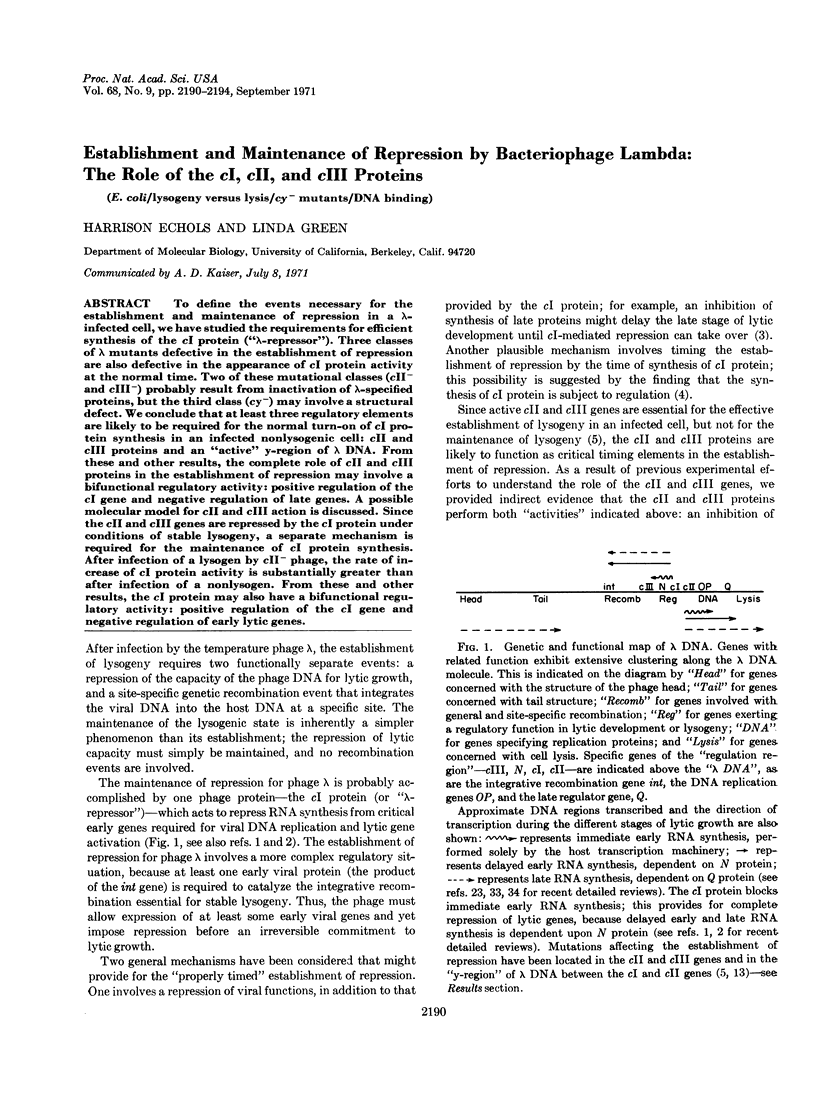
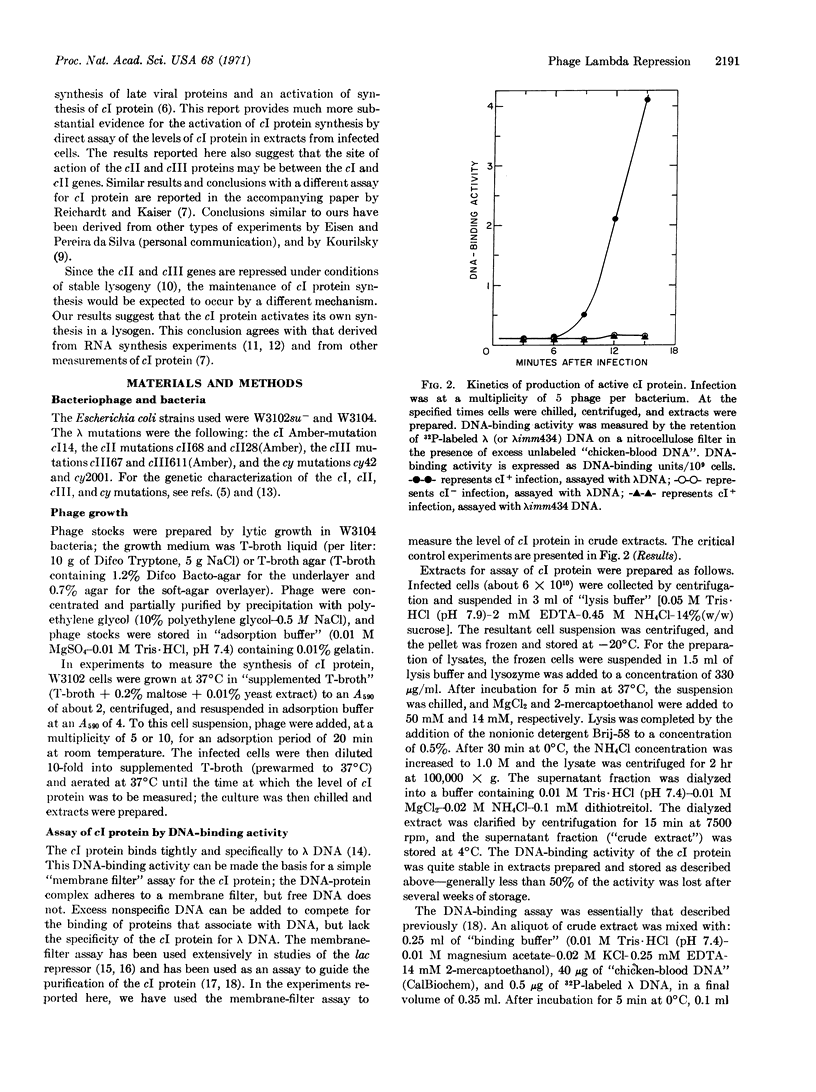
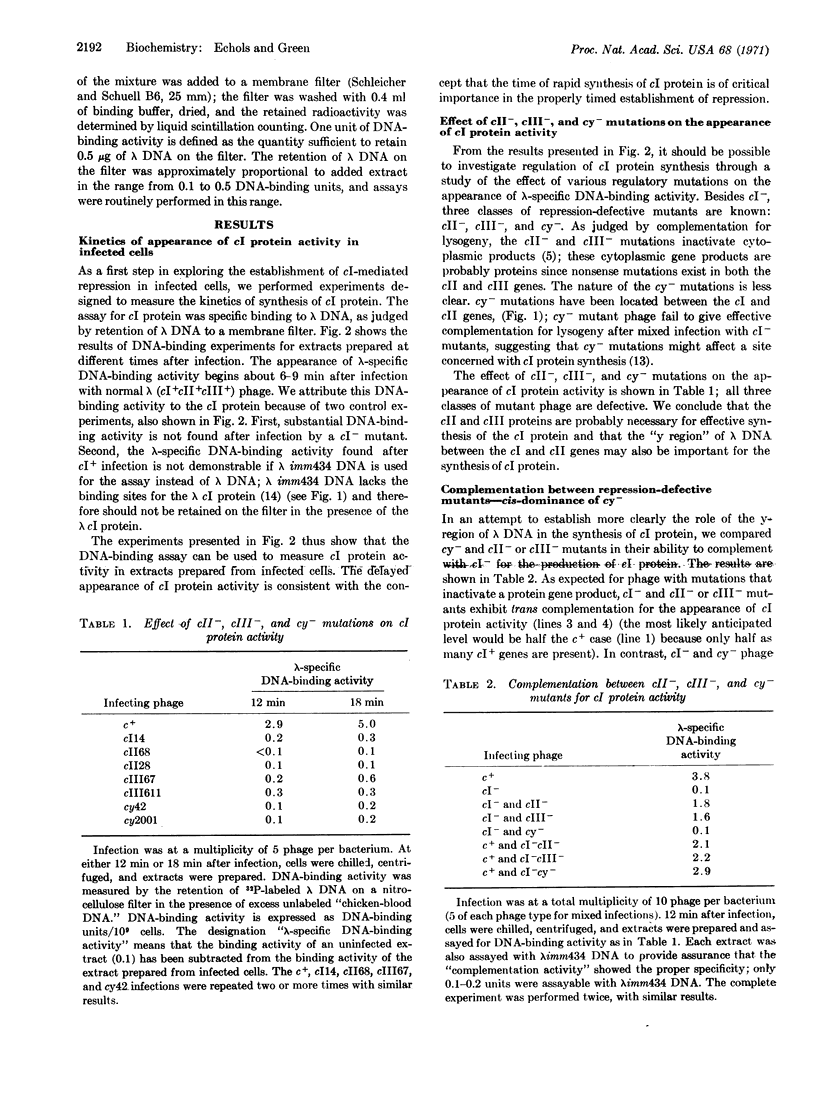
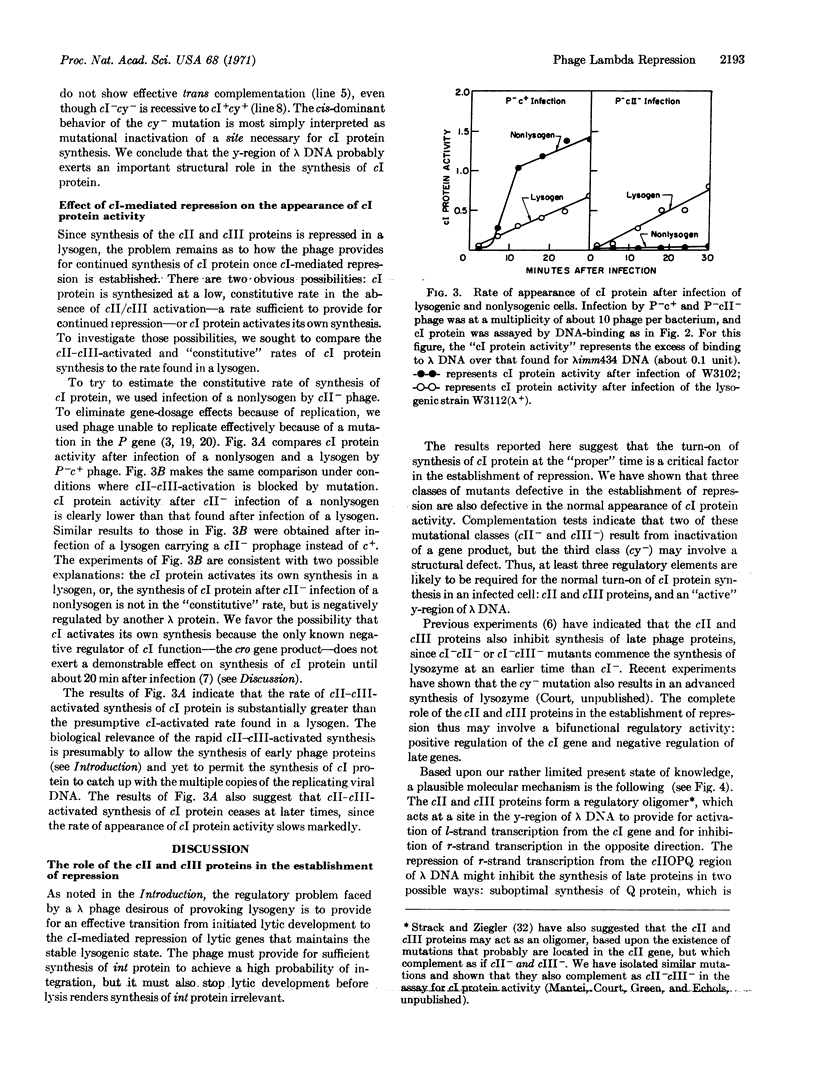
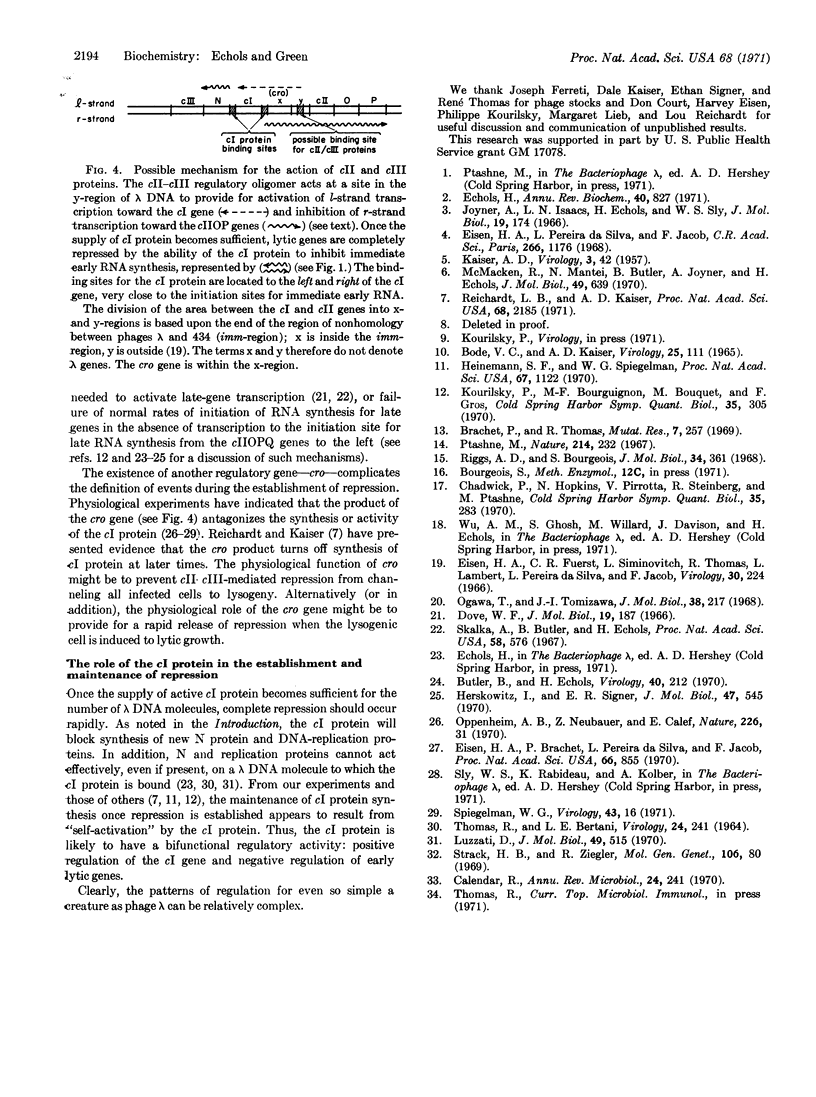
Selected References
These references are in PubMed. This may not be the complete list of references from this article.
- BODE V. C., KAISER A. D. REPRESSION OF THE C2 AND C3 CISTRONS OF PHAGE LAMBDA IN A LYSOGENIC BACTERIUM. Virology. 1965 Jan;25:111–121. doi: 10.1016/0042-6822(65)90258-8. [DOI] [PubMed] [Google Scholar]
- Brachet P., Thomas R. Mapping and functional analysis of y and CII mutants. Mutat Res. 1969 Mar-Apr;7(2):257–260. doi: 10.1016/0027-5107(69)90041-4. [DOI] [PubMed] [Google Scholar]
- Butler B., Echols H. Regulation of bacteriophage lambda development by gene N: properties of a mutation that bypasses N control of late protein synthesis. Virology. 1970 Feb;40(2):212–222. doi: 10.1016/0042-6822(70)90396-x. [DOI] [PubMed] [Google Scholar]
- Calendar R. The regulation of phage development. Annu Rev Microbiol. 1970;24:241–296. doi: 10.1146/annurev.mi.24.100170.001325. [DOI] [PubMed] [Google Scholar]
- Dove W. F. Action of the lambda chromosome. I. Control of functions late in bacteriophage development. J Mol Biol. 1966 Aug;19(1):187–201. doi: 10.1016/s0022-2836(66)80060-8. [DOI] [PubMed] [Google Scholar]
- Echols H. Lysogeny: viral repression and site-specific recombination. Annu Rev Biochem. 1971;40:827–854. doi: 10.1146/annurev.bi.40.070171.004143. [DOI] [PubMed] [Google Scholar]
- Eisen H. A., Fuerst C. R., Siminovitch L., Thomas R., Lambert L., Pereira da Silva L., Jacob F. Genetics and physiology of defective lysogeny in K12 (lambda): studies of early mutants. Virology. 1966 Oct;30(2):224–241. doi: 10.1016/0042-6822(66)90098-5. [DOI] [PubMed] [Google Scholar]
- Eisen H., Brachet P., Pereira da Silva L., Jacob F. Regulation of repressor expression in lambda. Proc Natl Acad Sci U S A. 1970 Jul;66(3):855–862. doi: 10.1073/pnas.66.3.855. [DOI] [PMC free article] [PubMed] [Google Scholar]
- Eisen H., Pereira da Silva L., Jacob F. Sur la régulation précoce du bactériophage lambda. C R Acad Sci Hebd Seances Acad Sci D. 1968 Mar 11;266(11):1176–1178. [PubMed] [Google Scholar]
- Heinemann S. F., Spiegelman W. G. Control of transcription of the repressor gene in bacteriophage lambda. Proc Natl Acad Sci U S A. 1970 Nov;67(3):1122–1129. doi: 10.1073/pnas.67.3.1122. [DOI] [PMC free article] [PubMed] [Google Scholar]
- Herskowitz I., Signer E. R. A site essential for expression of all late genes in bacteriophage lambda. J Mol Biol. 1970 Feb 14;47(3):545–556. doi: 10.1016/0022-2836(70)90321-9. [DOI] [PubMed] [Google Scholar]
- Joyner A., Isaacs L. N., Echols H., Sly W. S. DNA replication and messenger RNA production after induction of wild-type lambda bacteriophage and lambda mutants. J Mol Biol. 1966 Aug;19(1):174–186. doi: 10.1016/s0022-2836(66)80059-1. [DOI] [PubMed] [Google Scholar]
- KAISER A. D. Mutations in a temperate bacteriophage affecting its ability to lysogenize Escherichia coli. Virology. 1957 Feb;3(1):42–61. doi: 10.1016/0042-6822(57)90022-3. [DOI] [PubMed] [Google Scholar]
- Luzzati D. Regulation of lambda exonuclease synthesis: role of the N gene product and lambda repressor. J Mol Biol. 1970 Apr 28;49(2):515–519. doi: 10.1016/0022-2836(70)90261-5. [DOI] [PubMed] [Google Scholar]
- McMacken R., Mantei N., Butler B., Joyner A., Echols H. Effect of mutations in the c2 and c3 genes of bacteriophage lambda on macromolecular synthesis in infected cells. J Mol Biol. 1970 May 14;49(3):639–655. doi: 10.1016/0022-2836(70)90288-3. [DOI] [PubMed] [Google Scholar]
- Ogawa T., Tomizawa J. Replication of bacteriophage DNA. I. Replication of DNA of lambda phage defective in early functions. J Mol Biol. 1968 Dec 14;38(2):217–225. doi: 10.1016/0022-2836(68)90407-5. [DOI] [PubMed] [Google Scholar]
- Oppenheim A. B., Neubauer Z., Calef E. The antirepressor: a new element in the regulation of protein synthesis. Nature. 1970 Apr 4;226(5240):31–32. doi: 10.1038/226031a0. [DOI] [PubMed] [Google Scholar]
- Ptashne M. Specific binding of the lambda phage repressor to lambda DNA. Nature. 1967 Apr 15;214(5085):232–234. doi: 10.1038/214232a0. [DOI] [PubMed] [Google Scholar]
- Reichardt L., Kaiser A. D. Control of lambda repressor synthesis. Proc Natl Acad Sci U S A. 1971 Sep;68(9):2185–2189. doi: 10.1073/pnas.68.9.2185. [DOI] [PMC free article] [PubMed] [Google Scholar]
- Riggs A. D., Bourgeois S. On the assay, isolation and characterization of the lac repressor. J Mol Biol. 1968 Jul 14;34(2):361–364. doi: 10.1016/0022-2836(68)90260-x. [DOI] [PubMed] [Google Scholar]
- Skalka A., Butler B., Echols H. Genetic control of transcription during development of phage gamma. Proc Natl Acad Sci U S A. 1967 Aug;58(2):576–583. doi: 10.1073/pnas.58.2.576. [DOI] [PMC free article] [PubMed] [Google Scholar]
- Spiegelman W. G. Two states of expression of genes cl, rex, and N in lambda. Virology. 1971 Jan;43(1):16–33. doi: 10.1016/0042-6822(71)90220-0. [DOI] [PubMed] [Google Scholar]
- Strack H. B., Ziegler R. A new class of clear mutants from coliphage 434 hy not complementing CII and C3 mutants for lysogenization. Mol Gen Genet. 1969;106(1):80–88. doi: 10.1007/BF00332823. [DOI] [PubMed] [Google Scholar]
- THOMAS R., BERTANI L. E. ON THE CONTROL OF THE REPLICATION OF TEMPERATE BACTERIOPHAGES SUPERINFECTING IMMUNE HOSTS. Virology. 1964 Nov;24:241–253. doi: 10.1016/0042-6822(64)90163-1. [DOI] [PubMed] [Google Scholar]


